Evaluating Investment Decisions: Payback Period and NPV Analysis
VerifiedAdded on 2023/06/17
|7
|1313
|123
Report
AI Summary
This report provides an analysis of financial decision-making using the payback period and Net Present Value (NPV) methods, focusing on a case study of AJ plc, a chocolate manufacturing company in the UK. The report calculates and compares the payback periods and NPVs for two projects: Vegan Chocolate (Project A) and Vegan Spread (Project B). The analysis reveals that Project B has a shorter payback period, while Project A has a higher NPV. The report also discusses the importance of considering both financial and non-financial factors, such as government policies, in the decision-making process and their implications for stakeholders. Ultimately, the report concludes that effective decision-making is crucial for businesses to generate higher profits and revenue, and that using methods like payback period and NPV can aid in making informed investment decisions. Desklib provides resources for students to further explore these concepts.

BUSINESS DECISION
MAKING
MAKING
Paraphrase This Document
Need a fresh take? Get an instant paraphrase of this document with our AI Paraphraser
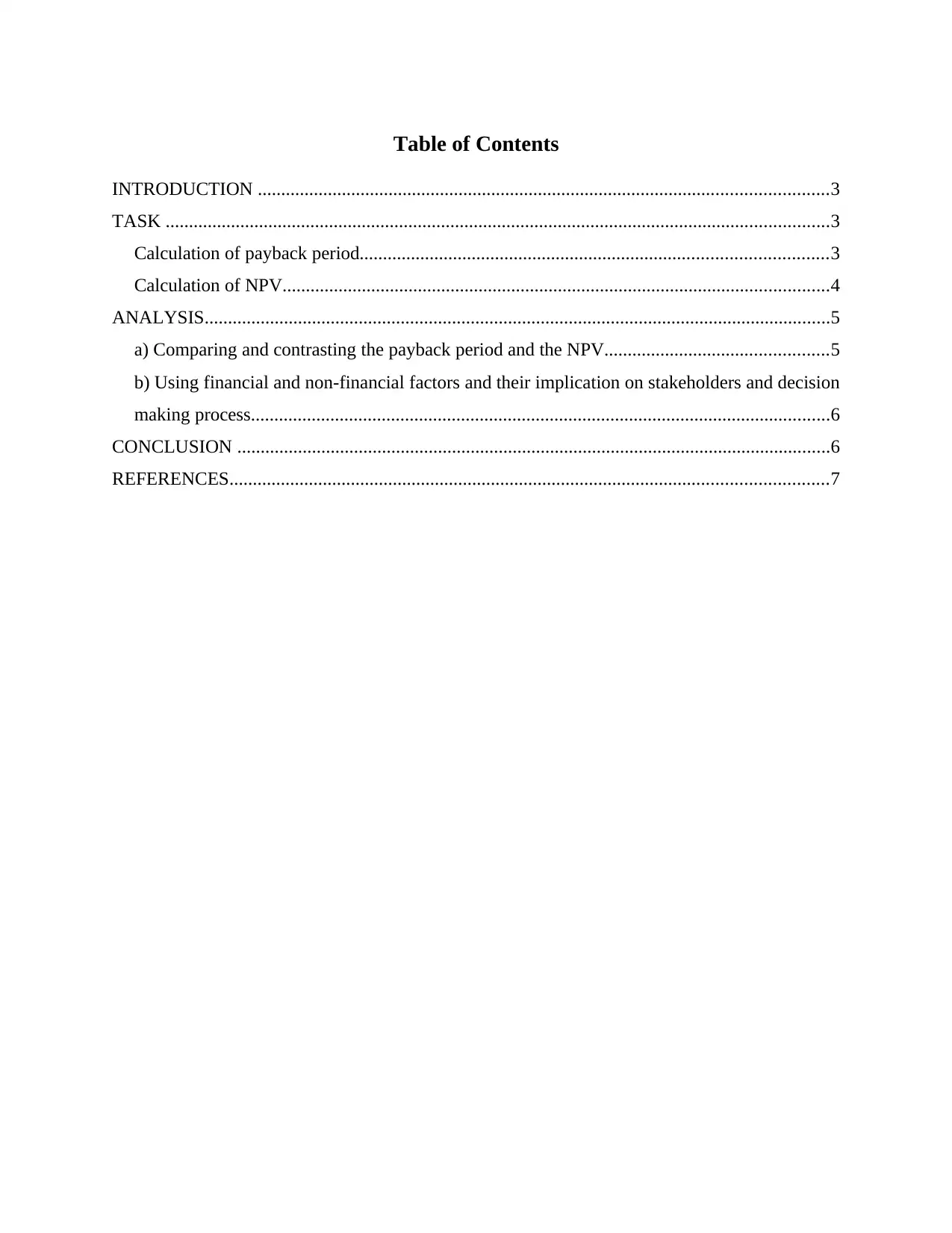
Table of Contents
INTRODUCTION ..........................................................................................................................3
TASK ..............................................................................................................................................3
Calculation of payback period....................................................................................................3
Calculation of NPV.....................................................................................................................4
ANALYSIS......................................................................................................................................5
a) Comparing and contrasting the payback period and the NPV................................................5
b) Using financial and non-financial factors and their implication on stakeholders and decision
making process............................................................................................................................6
CONCLUSION ...............................................................................................................................6
REFERENCES................................................................................................................................7
INTRODUCTION ..........................................................................................................................3
TASK ..............................................................................................................................................3
Calculation of payback period....................................................................................................3
Calculation of NPV.....................................................................................................................4
ANALYSIS......................................................................................................................................5
a) Comparing and contrasting the payback period and the NPV................................................5
b) Using financial and non-financial factors and their implication on stakeholders and decision
making process............................................................................................................................6
CONCLUSION ...............................................................................................................................6
REFERENCES................................................................................................................................7
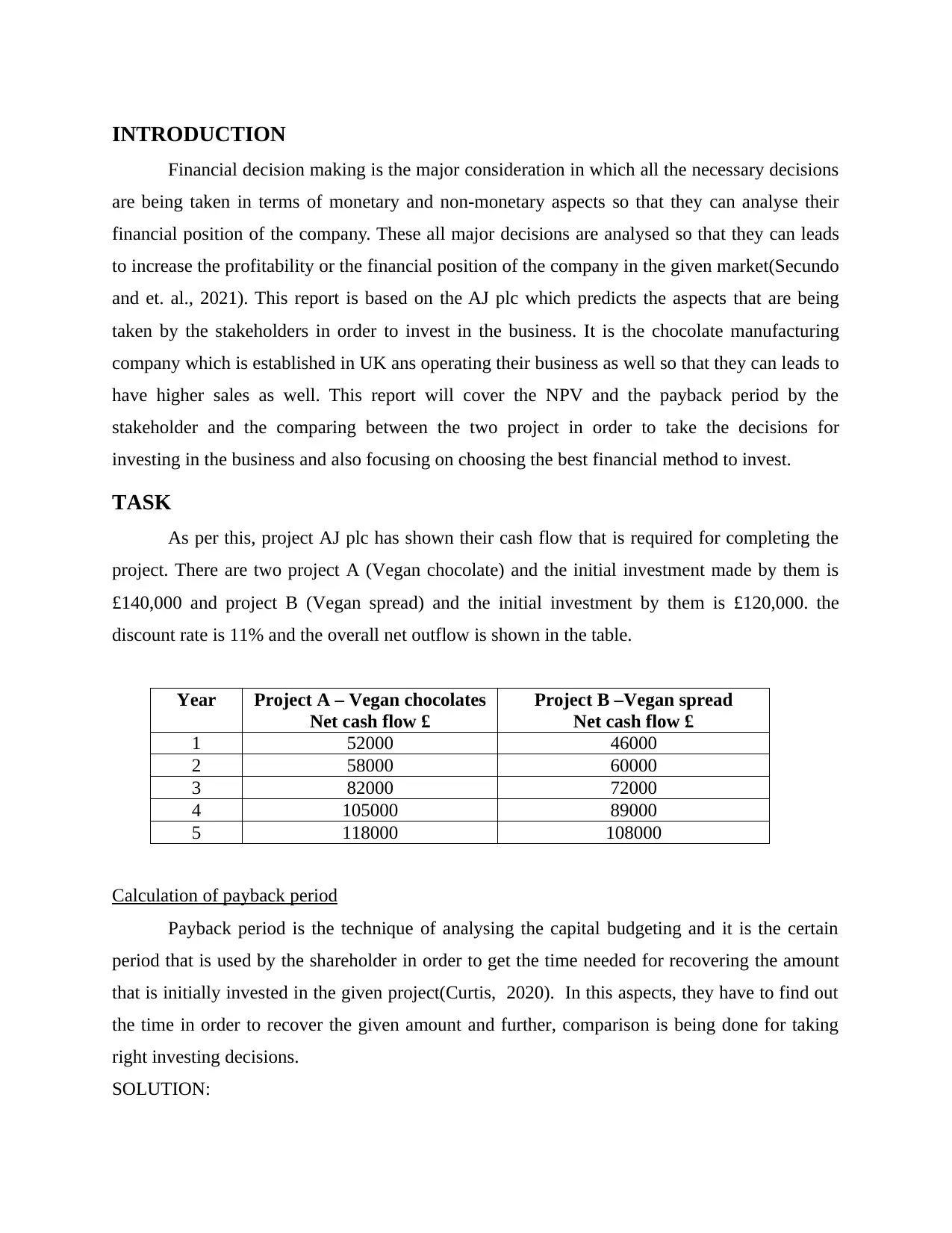
INTRODUCTION
Financial decision making is the major consideration in which all the necessary decisions
are being taken in terms of monetary and non-monetary aspects so that they can analyse their
financial position of the company. These all major decisions are analysed so that they can leads
to increase the profitability or the financial position of the company in the given market(Secundo
and et. al., 2021). This report is based on the AJ plc which predicts the aspects that are being
taken by the stakeholders in order to invest in the business. It is the chocolate manufacturing
company which is established in UK ans operating their business as well so that they can leads to
have higher sales as well. This report will cover the NPV and the payback period by the
stakeholder and the comparing between the two project in order to take the decisions for
investing in the business and also focusing on choosing the best financial method to invest.
TASK
As per this, project AJ plc has shown their cash flow that is required for completing the
project. There are two project A (Vegan chocolate) and the initial investment made by them is
£140,000 and project B (Vegan spread) and the initial investment by them is £120,000. the
discount rate is 11% and the overall net outflow is shown in the table.
Year Project A – Vegan chocolates
Net cash flow £
Project B –Vegan spread
Net cash flow £
1 52000 46000
2 58000 60000
3 82000 72000
4 105000 89000
5 118000 108000
Calculation of payback period
Payback period is the technique of analysing the capital budgeting and it is the certain
period that is used by the shareholder in order to get the time needed for recovering the amount
that is initially invested in the given project(Curtis, 2020). In this aspects, they have to find out
the time in order to recover the given amount and further, comparison is being done for taking
right investing decisions.
SOLUTION:
Financial decision making is the major consideration in which all the necessary decisions
are being taken in terms of monetary and non-monetary aspects so that they can analyse their
financial position of the company. These all major decisions are analysed so that they can leads
to increase the profitability or the financial position of the company in the given market(Secundo
and et. al., 2021). This report is based on the AJ plc which predicts the aspects that are being
taken by the stakeholders in order to invest in the business. It is the chocolate manufacturing
company which is established in UK ans operating their business as well so that they can leads to
have higher sales as well. This report will cover the NPV and the payback period by the
stakeholder and the comparing between the two project in order to take the decisions for
investing in the business and also focusing on choosing the best financial method to invest.
TASK
As per this, project AJ plc has shown their cash flow that is required for completing the
project. There are two project A (Vegan chocolate) and the initial investment made by them is
£140,000 and project B (Vegan spread) and the initial investment by them is £120,000. the
discount rate is 11% and the overall net outflow is shown in the table.
Year Project A – Vegan chocolates
Net cash flow £
Project B –Vegan spread
Net cash flow £
1 52000 46000
2 58000 60000
3 82000 72000
4 105000 89000
5 118000 108000
Calculation of payback period
Payback period is the technique of analysing the capital budgeting and it is the certain
period that is used by the shareholder in order to get the time needed for recovering the amount
that is initially invested in the given project(Curtis, 2020). In this aspects, they have to find out
the time in order to recover the given amount and further, comparison is being done for taking
right investing decisions.
SOLUTION:
⊘ This is a preview!⊘
Do you want full access?
Subscribe today to unlock all pages.

Trusted by 1+ million students worldwide
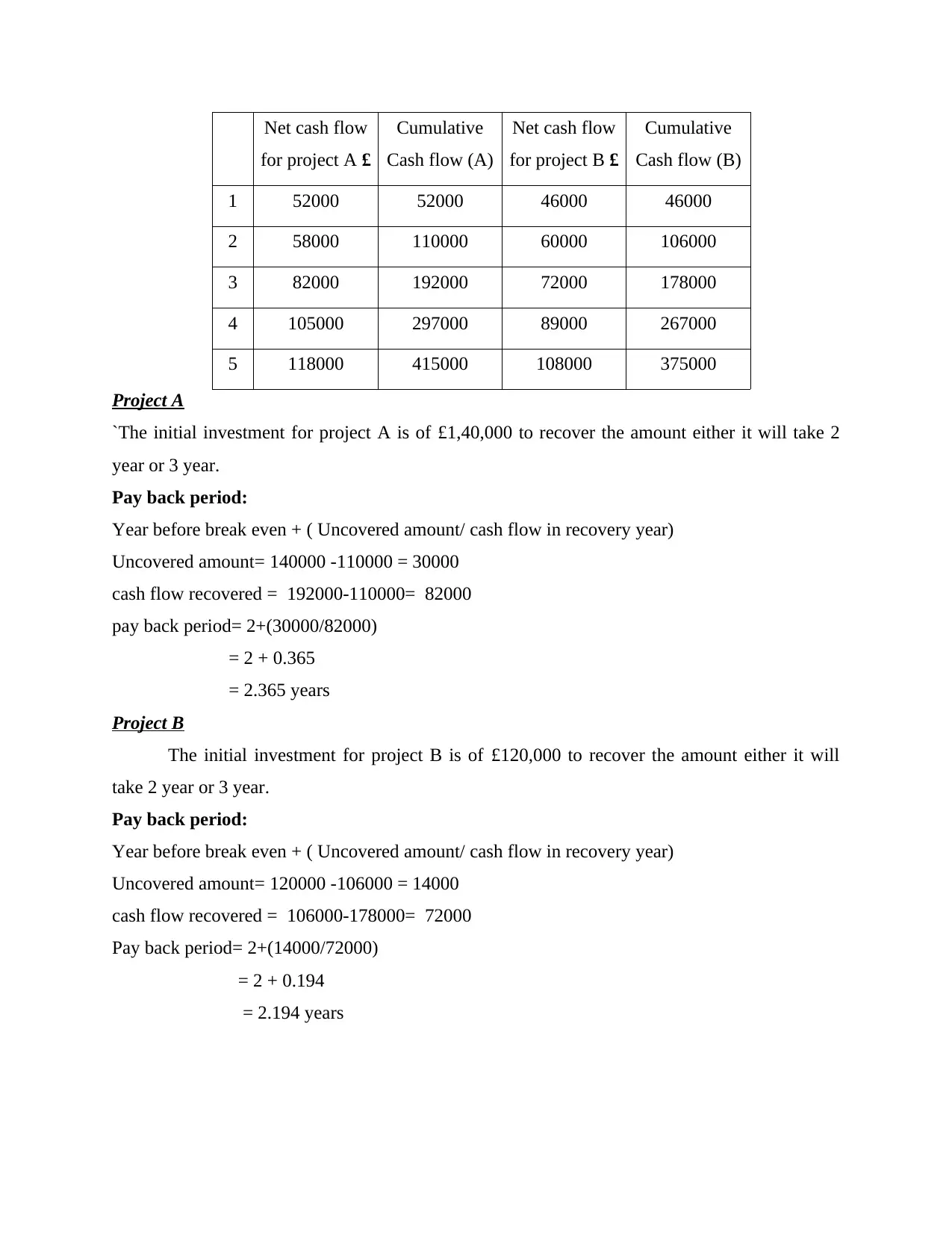
Net cash flow
for project A £
Cumulative
Cash flow (A)
Net cash flow
for project B £
Cumulative
Cash flow (B)
1 52000 52000 46000 46000
2 58000 110000 60000 106000
3 82000 192000 72000 178000
4 105000 297000 89000 267000
5 118000 415000 108000 375000
Project A
`The initial investment for project A is of £1,40,000 to recover the amount either it will take 2
year or 3 year.
Pay back period:
Year before break even + ( Uncovered amount/ cash flow in recovery year)
Uncovered amount= 140000 -110000 = 30000
cash flow recovered = 192000-110000= 82000
pay back period= 2+(30000/82000)
= 2 + 0.365
= 2.365 years
Project B
The initial investment for project B is of £120,000 to recover the amount either it will
take 2 year or 3 year.
Pay back period:
Year before break even + ( Uncovered amount/ cash flow in recovery year)
Uncovered amount= 120000 -106000 = 14000
cash flow recovered = 106000-178000= 72000
Pay back period= 2+(14000/72000)
= 2 + 0.194
= 2.194 years
for project A £
Cumulative
Cash flow (A)
Net cash flow
for project B £
Cumulative
Cash flow (B)
1 52000 52000 46000 46000
2 58000 110000 60000 106000
3 82000 192000 72000 178000
4 105000 297000 89000 267000
5 118000 415000 108000 375000
Project A
`The initial investment for project A is of £1,40,000 to recover the amount either it will take 2
year or 3 year.
Pay back period:
Year before break even + ( Uncovered amount/ cash flow in recovery year)
Uncovered amount= 140000 -110000 = 30000
cash flow recovered = 192000-110000= 82000
pay back period= 2+(30000/82000)
= 2 + 0.365
= 2.365 years
Project B
The initial investment for project B is of £120,000 to recover the amount either it will
take 2 year or 3 year.
Pay back period:
Year before break even + ( Uncovered amount/ cash flow in recovery year)
Uncovered amount= 120000 -106000 = 14000
cash flow recovered = 106000-178000= 72000
Pay back period= 2+(14000/72000)
= 2 + 0.194
= 2.194 years
Paraphrase This Document
Need a fresh take? Get an instant paraphrase of this document with our AI Paraphraser
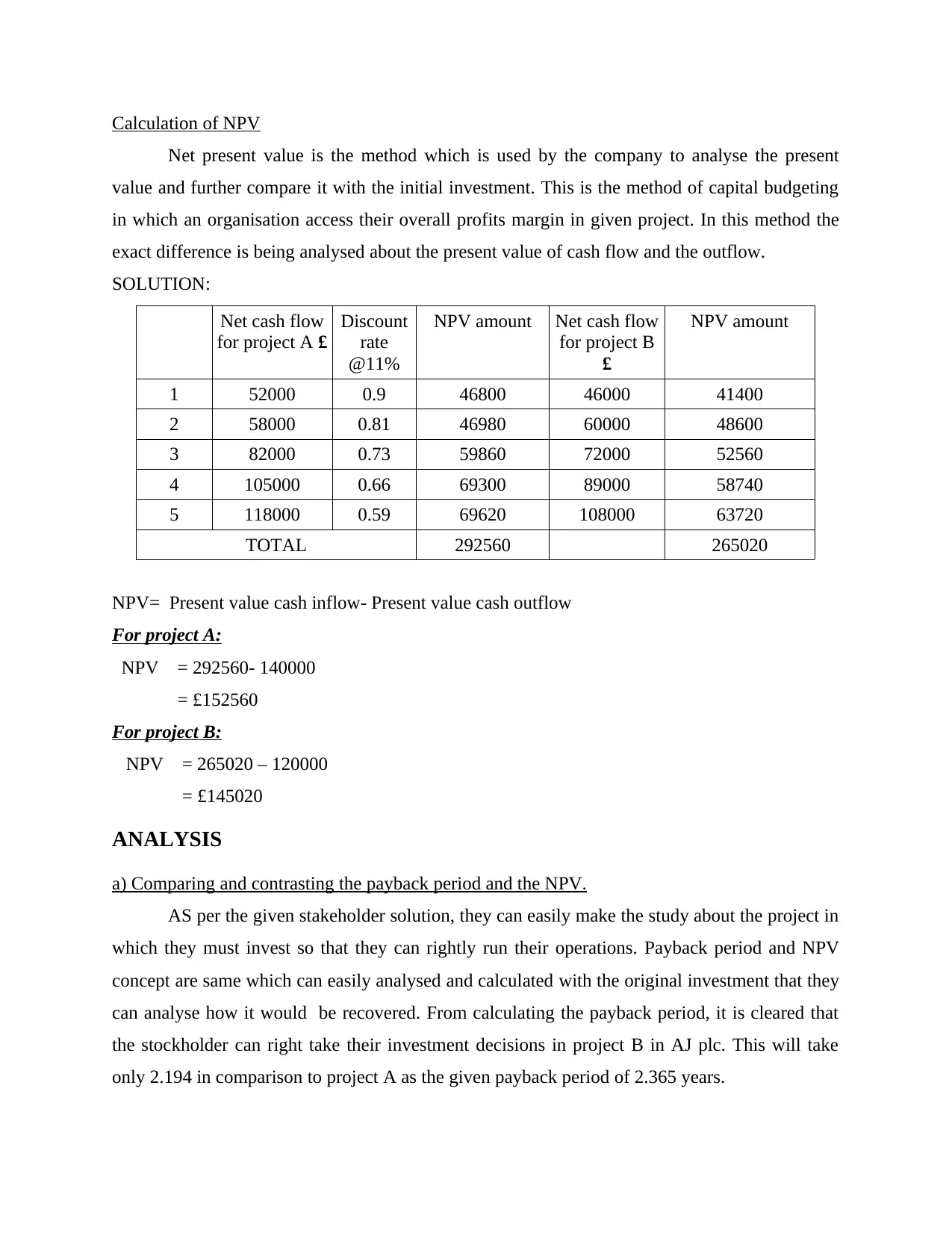
Calculation of NPV
Net present value is the method which is used by the company to analyse the present
value and further compare it with the initial investment. This is the method of capital budgeting
in which an organisation access their overall profits margin in given project. In this method the
exact difference is being analysed about the present value of cash flow and the outflow.
SOLUTION:
Net cash flow
for project A £
Discount
rate
@11%
NPV amount Net cash flow
for project B
£
NPV amount
1 52000 0.9 46800 46000 41400
2 58000 0.81 46980 60000 48600
3 82000 0.73 59860 72000 52560
4 105000 0.66 69300 89000 58740
5 118000 0.59 69620 108000 63720
TOTAL 292560 265020
NPV= Present value cash inflow- Present value cash outflow
For project A:
NPV = 292560- 140000
= £152560
For project B:
NPV = 265020 – 120000
= £145020
ANALYSIS
a) Comparing and contrasting the payback period and the NPV.
AS per the given stakeholder solution, they can easily make the study about the project in
which they must invest so that they can rightly run their operations. Payback period and NPV
concept are same which can easily analysed and calculated with the original investment that they
can analyse how it would be recovered. From calculating the payback period, it is cleared that
the stockholder can right take their investment decisions in project B in AJ plc. This will take
only 2.194 in comparison to project A as the given payback period of 2.365 years.
Net present value is the method which is used by the company to analyse the present
value and further compare it with the initial investment. This is the method of capital budgeting
in which an organisation access their overall profits margin in given project. In this method the
exact difference is being analysed about the present value of cash flow and the outflow.
SOLUTION:
Net cash flow
for project A £
Discount
rate
@11%
NPV amount Net cash flow
for project B
£
NPV amount
1 52000 0.9 46800 46000 41400
2 58000 0.81 46980 60000 48600
3 82000 0.73 59860 72000 52560
4 105000 0.66 69300 89000 58740
5 118000 0.59 69620 108000 63720
TOTAL 292560 265020
NPV= Present value cash inflow- Present value cash outflow
For project A:
NPV = 292560- 140000
= £152560
For project B:
NPV = 265020 – 120000
= £145020
ANALYSIS
a) Comparing and contrasting the payback period and the NPV.
AS per the given stakeholder solution, they can easily make the study about the project in
which they must invest so that they can rightly run their operations. Payback period and NPV
concept are same which can easily analysed and calculated with the original investment that they
can analyse how it would be recovered. From calculating the payback period, it is cleared that
the stockholder can right take their investment decisions in project B in AJ plc. This will take
only 2.194 in comparison to project A as the given payback period of 2.365 years.
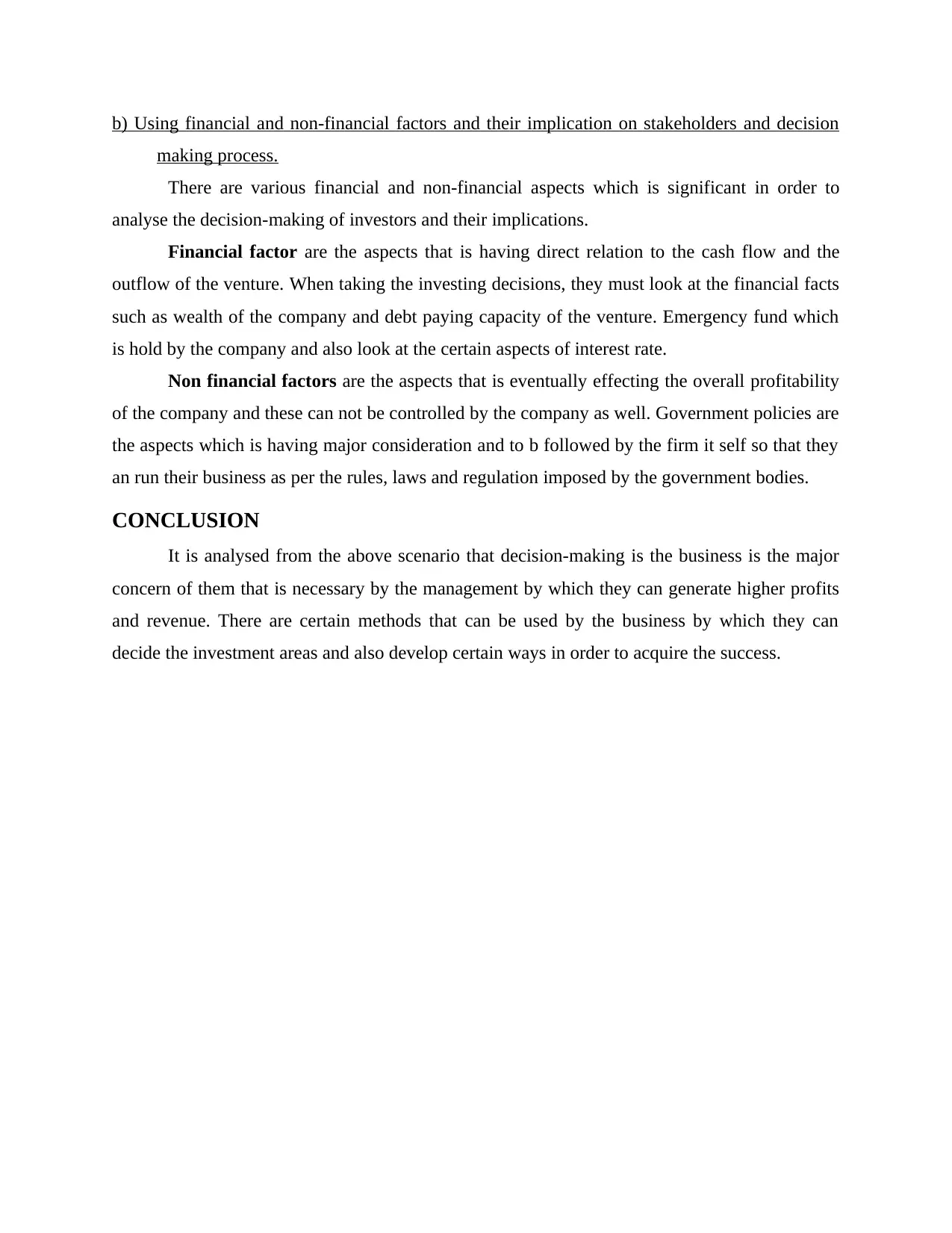
b) Using financial and non-financial factors and their implication on stakeholders and decision
making process.
There are various financial and non-financial aspects which is significant in order to
analyse the decision-making of investors and their implications.
Financial factor are the aspects that is having direct relation to the cash flow and the
outflow of the venture. When taking the investing decisions, they must look at the financial facts
such as wealth of the company and debt paying capacity of the venture. Emergency fund which
is hold by the company and also look at the certain aspects of interest rate.
Non financial factors are the aspects that is eventually effecting the overall profitability
of the company and these can not be controlled by the company as well. Government policies are
the aspects which is having major consideration and to b followed by the firm it self so that they
an run their business as per the rules, laws and regulation imposed by the government bodies.
CONCLUSION
It is analysed from the above scenario that decision-making is the business is the major
concern of them that is necessary by the management by which they can generate higher profits
and revenue. There are certain methods that can be used by the business by which they can
decide the investment areas and also develop certain ways in order to acquire the success.
making process.
There are various financial and non-financial aspects which is significant in order to
analyse the decision-making of investors and their implications.
Financial factor are the aspects that is having direct relation to the cash flow and the
outflow of the venture. When taking the investing decisions, they must look at the financial facts
such as wealth of the company and debt paying capacity of the venture. Emergency fund which
is hold by the company and also look at the certain aspects of interest rate.
Non financial factors are the aspects that is eventually effecting the overall profitability
of the company and these can not be controlled by the company as well. Government policies are
the aspects which is having major consideration and to b followed by the firm it self so that they
an run their business as per the rules, laws and regulation imposed by the government bodies.
CONCLUSION
It is analysed from the above scenario that decision-making is the business is the major
concern of them that is necessary by the management by which they can generate higher profits
and revenue. There are certain methods that can be used by the business by which they can
decide the investment areas and also develop certain ways in order to acquire the success.
⊘ This is a preview!⊘
Do you want full access?
Subscribe today to unlock all pages.

Trusted by 1+ million students worldwide
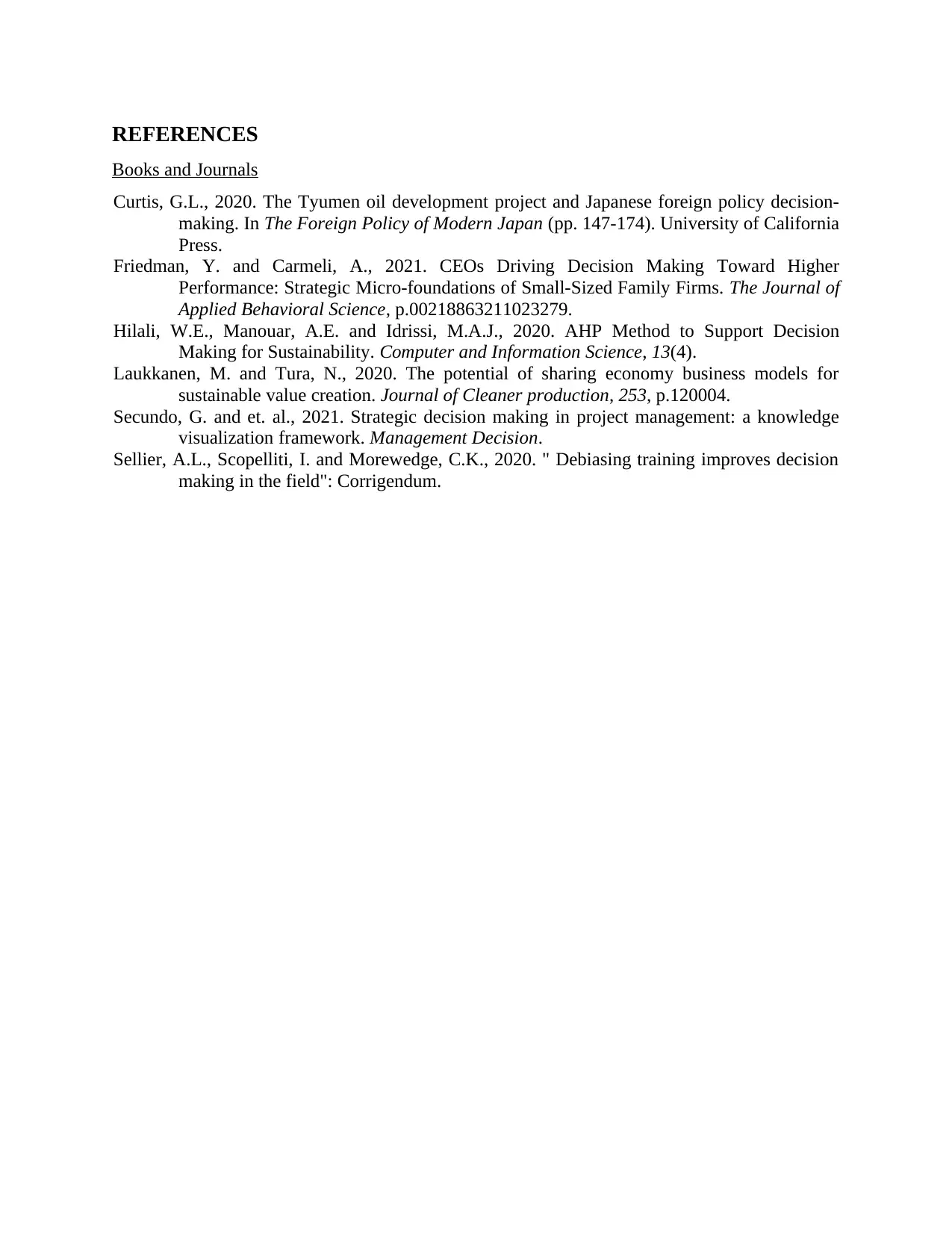
REFERENCES
Books and Journals
Curtis, G.L., 2020. The Tyumen oil development project and Japanese foreign policy decision-
making. In The Foreign Policy of Modern Japan (pp. 147-174). University of California
Press.
Friedman, Y. and Carmeli, A., 2021. CEOs Driving Decision Making Toward Higher
Performance: Strategic Micro-foundations of Small-Sized Family Firms. The Journal of
Applied Behavioral Science, p.00218863211023279.
Hilali, W.E., Manouar, A.E. and Idrissi, M.A.J., 2020. AHP Method to Support Decision
Making for Sustainability. Computer and Information Science, 13(4).
Laukkanen, M. and Tura, N., 2020. The potential of sharing economy business models for
sustainable value creation. Journal of Cleaner production, 253, p.120004.
Secundo, G. and et. al., 2021. Strategic decision making in project management: a knowledge
visualization framework. Management Decision.
Sellier, A.L., Scopelliti, I. and Morewedge, C.K., 2020. " Debiasing training improves decision
making in the field": Corrigendum.
Books and Journals
Curtis, G.L., 2020. The Tyumen oil development project and Japanese foreign policy decision-
making. In The Foreign Policy of Modern Japan (pp. 147-174). University of California
Press.
Friedman, Y. and Carmeli, A., 2021. CEOs Driving Decision Making Toward Higher
Performance: Strategic Micro-foundations of Small-Sized Family Firms. The Journal of
Applied Behavioral Science, p.00218863211023279.
Hilali, W.E., Manouar, A.E. and Idrissi, M.A.J., 2020. AHP Method to Support Decision
Making for Sustainability. Computer and Information Science, 13(4).
Laukkanen, M. and Tura, N., 2020. The potential of sharing economy business models for
sustainable value creation. Journal of Cleaner production, 253, p.120004.
Secundo, G. and et. al., 2021. Strategic decision making in project management: a knowledge
visualization framework. Management Decision.
Sellier, A.L., Scopelliti, I. and Morewedge, C.K., 2020. " Debiasing training improves decision
making in the field": Corrigendum.
1 out of 7
Related Documents
Your All-in-One AI-Powered Toolkit for Academic Success.
+13062052269
info@desklib.com
Available 24*7 on WhatsApp / Email
![[object Object]](/_next/static/media/star-bottom.7253800d.svg)
Unlock your academic potential
Copyright © 2020–2025 A2Z Services. All Rights Reserved. Developed and managed by ZUCOL.

